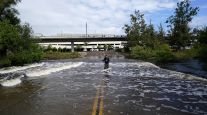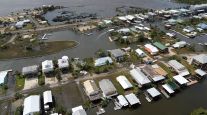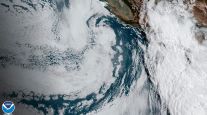Tropical Storm Fred Makes Landfall on Florida’s Panhandle
[Stay on top of transportation news: Get TTNews in your inbox.]
Tropical Storm Fred crashed ashore on the Florida panhandle with powerful winds, becoming the fourth system of the 2021 hurricane season to strike the U.S.
Fred’s top winds were 65 miles per hour when it made landfall near Cape San Blas, near Panama City, Fla., the National Hurricane Center said in an update at 2:15 p.m. local time. A storm becomes a hurricane when its winds reach 74 mph.
A storm surge warning was in place for Florida’s panhandle, from Indian Pass to Yankeetown. Fred is expected to quickly weaken after landfall.
Fred comes ashore during a period when extreme weather has been battering the globe. July was the hottest month ever recorded on Earth. Wildfires have burned more than 1 million acres in California. And last week, Sicily appears to have broken continental Europe’s heat record: 119.8 degrees Fahrenheit.
In the Caribbean, Tropical Depression Grace is lashing the Dominican Republic, Haiti, Cuba and Jamaica with rain. It comes after nearly 1,300 people were killed during Aug. 14’s 7.2 magnitude earthquake in Haiti. The storm is expected to reach tropical strength over the next two days, eventually striking Mexico.
While the current forecast calls for Grace to restrengthen and drive west across Haiti and the Caribbean and into Mexico, there is still a chance it could veer to the north and strike Texas, Jim Rouiller, lead meteorologist for the Energy Weather Group, said. That would put pressure on health care officials dealing with a massive outbreak of the COVID-19 delta variant across the state.
A third storm, to be named Henri, will most likely form soon. All of the activity is a reminder that this is the start of the most active phase of the Atlantic storm season, which switches into high gear around mid-August, Rouiller said. Ocean temperatures, which provide fuel for storms, are very warm. There is an increase in thunderstorms coming off Africa and dry air and wind shear, which can stop storms, has fallen off.
“I think this does mark the beginning of a prolonged period,” Rouiller said. “Everything is in place.”
Seven storms have spun up across the Atlantic in 2021 so far, a milestone that is usually reached by mid-September, the hurricane center said. While storms in the Gulf can disrupt offshore natural gas and oil production, Fred is forecast to stay mostly away from those areas, which are located off the coasts of Texas and Louisiana.
An average of 14 storms are named in the Atlantic each year and in 2020 a record 30 storms swept across the basin.
Want more news? Listen to today's daily briefing below or go here for more info:




